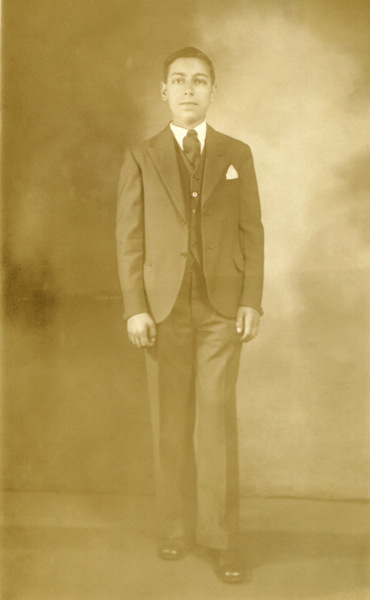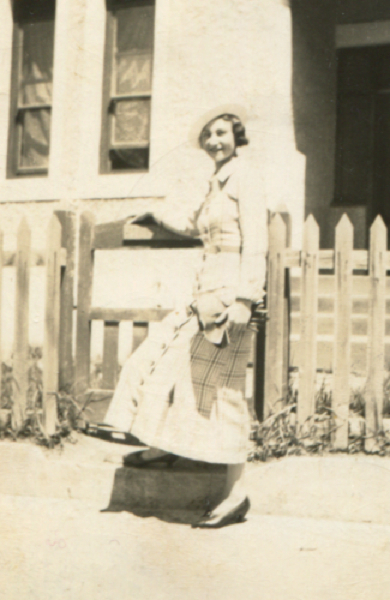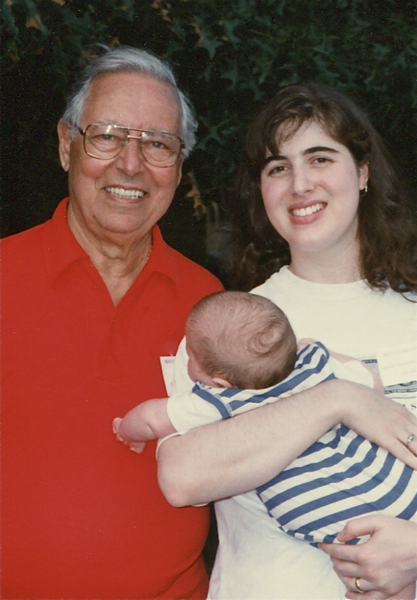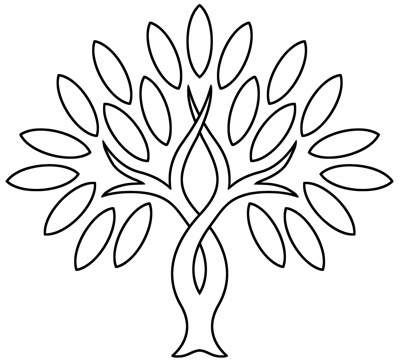|
Our family's founders were Yisrael and Sheine Esther Bris. They lived in Skapiškis [skop-ISH-kiss], a very small town in northeastern Lithuania.
Between 1847 and 1874, they had five children who lived to adulthood. Certainly, these were not the only children they had. Over nearly 30 years, there were probably at least 10 or 12 children, but only five escaped being carried off by pneumonia, cholera, hypothermia, starvation, conscription, pogroms, or invasion by Russia's neighbors. These five survived to become our ancestors.
The eldest was Chana Mere, who married Israel Hirsh Maler, a tinsmith. They lived in the tiny village of Kvetkai, about a 32 km drive north of Skapiškis. Israel Hirsh's brothers worked the local grain mill, from which the Maler family got its name. Chana Mere and Israel Hirsh had five children.
The second eldest was Jehudah Menashe, who made wood shingles for roofing. He married Chaia Ita Maas, whose brother Velvel owned a dry-goods store in Biržai [beer-ZHEYE], about a 32 km drive west of Kvetkai. Menasha and Chaia Ita had nine children in Biržai.
The third sibling was Avram Notte, who owned or managed a farm property in Ukmergė [ook-MAYR-geh], the southernmost of any of his siblings, fully 102 km south of Skapiškis. He raised cattle and provided meat to local communities: the kosher parts to the Jews, and the non-kosher parts to the Gentiles. He married Feige Kusner and they had seven children. In what was probably an attempt to duck military conscripton, Notte changed his name from Bris to Skaist, and changed all his children's names also. We don't know what year he did this, nor where the name Skaist came from.
The fourth sibling was Buna Ita, who married Yitzchok Elia Glas, a shoemaker. They lived in Papilys, the tiny village right next to Kvetkai, just 12 km southwest. They had four children.
The youngest was Elia Pinchus, who married Rivka Mirvish and raised their two children in Vabalninkas, a 28 km drive south from Biržai. By the time he emigrated in the 1920s, he was a farmer like his next elder brother.
Life in the Russian Empire was miserable for Jews, and at the end of the 19th century there was a massive wave of emigration, looking for opportunity in a new country. Gold and diamonds had been discovered in South Africa, and many Lithuanian Jews emigrated there.
The first family member to leave Lithuania was Jehudah Menashe Bris, by then a widower, in 1898. He went first to Johannesburg, but the Second Boer War forced him south to Cape Town.
By ones and twos, the teenaged and young-adult grandchildren of Yisrael and Sheine Esther also began fleeing Lithuania. The eldest three branches of the family were torn apart as some brothers and sisters went to South Africa and some to the United States.
By 1930, four of the original five Briss siblings and 23 of their children had left Lithuania...
To South Africa:
- Isaac Miller
- Menashe Briss
- Isaac Briss
- Hoda Briss Posvoletzky
- Annie Briss Miller
- Tzippa Briss Hotz
- Avram Josset
- Elia Briss
- David Bruss
- Sonia Briss Sadur
To the United States:
- Chana Mere Briss Maler
- Menasha "Jack" Miller
- Ida Miller Annis
- Sarah Miller Plotkin
- Annie Miller Davidson
- Morris Briss
- Rose Briss Annis
- Fannie Briss
- Harry Briss
- Mollie Skaist Wolk
- Samuel Briss
- Buna Ita Briss Glass
- Morris Glass
- Anna Glass Lerner
- Israel Glass
To Havana, Cuba:
In South Africa, family members lived in Cape Town, Paarl, and Johannesburg.
In the United States, family members lived in and around Philadelphia and Boston.
In the 1930s, the family branches on both sides of the Atlantic were saved from being lost to each other forever by two young cousins from the first generation to be born outside Lithuania. Philip Briss, in Boston, and his cousin Annie Posvoletzky, in Cape Town, began penpalling as teenagers and developed an extraordinary correspondence that lasted decades. As Annie described the growth of the family branches in Africa, Philip kept detailed notes on the names she mentioned, thus Phil became the Briss Family's first historian and genealogist. If not for Phil and Annie's letters, we would not have our extraordinary knowledge of the global Briss Family branches today.
By the late 1930s the only family members left in Lithuania were two of Notte Skaist's children and their families. Zundel Skaist was a successful professional photographer in a Baltic shore resort town on the western side of Lithuania. He and his wife had three children. Zundel's sister Yentel was also married and had a son.
In 1941, when the Nazis invaded Lithuania, the Lithuanians turned violently on the Jews in their own towns. Tragically, Zundel, Yentel, and their families were killed by their own Lithuanian neighbors.
In the US and South Africa, the family branches in their respective cities remained tight-knit, with first and second cousins growing up as close as siblings. In Massachusetts, almost everyone lived in Brookline or the Blue Hill Avenue area connecting Dorchester, Roxbury, and Mattapan. Vibrant Jewish communities also flourished in Philadelphia, Cape Town, and Johannesburg.
The late mid-20th century brought big changes and the beginning of a new chapter of family migration. "Blockbusting" real-estate tactics in Dorchester-Roxbury-Mattapan caused many Jewish families to leave for other towns. Increasing violence and crime in South African cities prompted Jewish families there to begin moving to Australia.
I am the eldest grandchild of Phil Briss's youngest sister, Florence. In 1992, when I was 19, I wrote to Uncle Phil and expressed interest in hearing about the family history. Uncle Phil was thrilled to have a new audience and letter-writing partner, and we exchanged letters about once a month for years. I sorted and organized his massive collection of old family photographs, and began locating documents in archives and municipal offices to fill in some of the gaps in his records. By the time Phil left us in 2004, the torch had been joyfully passed and joyfully accepted.
Today the Briss Family is in its sixth generation of descent from its founders, numbering over 400 living cousins around the world. I keep track of the growth of all the family branches, and I continue to gather information about our origins and travels.
My favorite part of what I do is helping to reunite distant cousins. I had the honor of facilitating the reunion of two descendants of the Miller branch of the family. A hundred years ago, a brother and a sister were parted by the Atlantic and never saw each other again. In 2013, their granddaughters met each other for the first time and saw the family resemblance in each others' smiles. From Lithuania, to Cape Town and Boston, to Hawaii, and finally to Sidney, the journey completed itself in an embrace, and somewhere, a brother and his littlest sister rejoiced.
I am very happy to serve as your family genealogist, historian, archivist, and webmistress, and to continue to fulfil Uncle Phil's wish to keep all the cousins in touch with each other, all over the world. Please feel free to contact me via the update form to ask about our history, to contribute photographs or documents, or for assistance with family tree projects for school or scout activities.
DID YOU KNOW?
"Bris" is a form of the Hebrew word "brit," which means "covenant." The word "brit" appears frequently in Jewish scriptures. After the great flood in the Book of Genesis, a rainbow was set in the sky to symbolize the covenant made with Noah. Genesis 9:13 says, "I have set my bow in the cloud, and it shall be a sign of the covenant between me and the earth." The rainbow is "ot ha-brit," the sign of the covenant.
The name of our ancestress Sheine Esther is the most popular recurring name in the Briss Family. At least nine of her great-granddaughters were named after her. Her name means "beautiful star."
Five granddaughters of Chaia Ita Bris were named after her, usually with English names Ida or Edith.
There are four sets of twins and one set of triplets in our family.
The most common birthday in our family is October 3, with five non-multiple cousins sharing it.
Although a formal family-wide count has never been taken, we seem to have a greater-than-average number of left-handers.
The most distant relationship between any two living family members is fifth cousins.
The lines from Yisrael Bris through his sons, grandsons, and great-grandsons wound up bearing four different surnames: Briss, Skaist, Josset, and Bruss.
Ida Maler, the first family member to immigrate to the United States, arrived on the RMS Carpathia in 1905. Seven years later, when the RMS Titanic struck an iceberg and sank on her maiden voyage, the Carpathia was the ship that rescued all 710 survivors.
There is a strong family tradition of excellence in yarn and fiber arts such as knitting, crocheting, and decorative stitching.
Home
|

Philip Briss, Boston, early 1930s

Annie Posvoletzky, Cape Town, 1936

Phil Briss and Joyce Rowland
at the 1996 Briss Family Reunion
in Bridgewater, Massachusetts

The Briss Family Tree
designed by family friend and renowned artist
Melenda K. Moore,
whose magnificent stained-glass windows adorn
Congregation Beth Chaim
in Princeton Junction, New Jersey,
and Temple Shir Ami in Newtown, Pennsylvania.
|
BRISS COUSINS DOING AWESOME THINGS
- Steve Schwartz, great-great-grandson of Yisrael and Sheine Esther Bris:
Radio producer at WGBH Boston 89.7 FM for 27 years, host of Jazz from Studio Four.
- Pamela Skaist-Levy, great-great-granddaughter of Yisrael and Sheine Esther Bris:
Fashion designer, co-founder of Juicy Couture and Skaist-Taylor, and the only Briss Family member ever honored with a Gold Label Barbie doll made in her image.
- Eric Schwartz, great-great-great-grandson of Yisrael and Sheine Esther Bris:
Radio producer at KNON Dallas/Fort Worth 89.3 FM since 1992, host of Lone Star Dead.
- Peter Narun, great-great-great-grandson of Yisrael and Sheine Esther Bris:
Classical guitarist and recording artist of the album Origin.
- Aly Raisman, great-great-great-great-granddaughter of Yisrael and Sheine Esther Bris:
Olympic Gold-winning gymnast and US Women's Gymnastics team captain, and Dancing With the Stars contestant.
|



